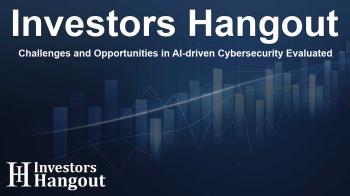Challenges and Opportunities in AI-driven Cybersecurity Evaluated

Arelion Reports on Business Leaders' Skepticism Towards AI-driven Cybersecurity
Recent findings reveal that an alarming 90 percent of business leaders express a lack of confidence in AI-based cybersecurity tools. This sentiment comes from an insightful report released by Arelion, showcasing trends in decision-making related to cybersecurity investments.
The Rise of AI in Cybersecurity
In the modern landscape of cyber threats, many decision-makers believe AI tools are more vulnerable to being outsmarted by hackers compared to human-operated systems. This is evidenced by the significant concerns from leaders across various sectors. Particularly, 34 percent of business leaders in the United States along with 29 percent in the UK voiced their fears regarding the capabilities of AI in defending against cybercriminal activities.
Cyber Threats Identified
The report indicates that enterprise network decision makers rank AI-assisted cybersecurity threats as their primary challenge. A noteworthy 65 percent project that DDoS attacks will increasingly be executed by AI in the upcoming years. This is compounded by the reality that 25 percent are currently experiencing these attacks tailored to bypass AI-driven defenses.
A Balancing Act: Benefits vs. Risks
Despite the apprehensions related to AI, the report emphasizes its potential benefits. Approximately 55 percent of network decision makers do not find AI to be overhyped, as they observe tangible business advantages from its implementation. Furthermore, 68 percent are open to allowing AI more involvement in their network operations, highlighting a shift towards integrating AI into everyday business practices.
Concerns Over Complexity and Skills
However, having AI in the mix doesn’t come without its drawbacks. A substantial 70 percent of business leaders report that AI complicates network operations. Additionally, there are fears that reliance on technology could lead to a decline in critical human skills necessary for managing networks effectively. This concern is magnified by earlier findings showcasing that nearly 48 percent of enterprise decision makers struggle to find qualified staff.
The Future of Network and Cybersecurity
As technology evolves, so too does the approach to cybersecurity. Business leaders foresee a dual-edged reality where AI can both facilitate attacks and enhance defensive measures. Mattias Fridström, Chief Evangelist at Arelion, aptly summarized this duality, asserting that the threat posed by cybercriminals is incessant and will continue to escalate. Yet, he acknowledges that AI offers valuable cybersecurity solutions, urging companies to be prepared for a long battle against evolving cyber threats.
The Need for External Support
Fridström emphasizes the necessity for enterprises to seek outside assistance to navigate the complex AI landscape in cybersecurity. He insists that no organization can effectively manage these challenges alone, indicating the importance of collaboration and leveraging external resources to bolster defenses.
Understanding the Methodology
The insights shared in the report derive from an extensive survey conducted by Arelion in collaboration with Savanta, a firm renowned for digital data gathering. The study, which engaged 510 industry representatives, focused on enterprises with more than 2,000 employees spanning diverse sectors, including Information Services and Manufacturing.
About Arelion
Arelion specializes in addressing global connectivity issues for multinational companies reliant on digital infrastructure. Positioned atop the world's leading IP backbone, Arelion provides services that enhance connectivity for over 700 cloud, security, and content providers. Their offerings are designed for resilience, connecting directly to major cloud services such as Amazon Web Services and Microsoft Azure across various regions.
Frequently Asked Questions
What does the Arelion report reveal about business leaders' opinions on AI?
The report reveals that 90 percent of business leaders lack confidence in AI cybersecurity solutions, fearing they are vulnerable to cyber attacks.
What percentage of decision-makers believe AI will increase DDoS attacks?
65 percent of decision-makers anticipate that DDoS attacks will be increasingly executed by AI in the near future.
What are the primary concerns reported by business leaders regarding AI?
The top concerns include increased complexity of network operations and a loss of critical human skills due to reliance on AI.
How do business leaders perceive the benefits of AI?
Over half of senior network decision makers see real benefits from AI and do not believe that AI is overhyped.
What is the call to action for companies regarding AI cybersecurity?
Companies are encouraged to seek external support and collaboration to effectively manage the complexities brought on by AI in cybersecurity.
About Investors Hangout
Investors Hangout is a leading online stock forum for financial discussion and learning, offering a wide range of free tools and resources. It draws in traders of all levels, who exchange market knowledge, investigate trading tactics, and keep an eye on industry developments in real time. Featuring financial articles, stock message boards, quotes, charts, company profiles, and live news updates. Through cooperative learning and a wealth of informational resources, it helps users from novices creating their first portfolios to experts honing their techniques. Join Investors Hangout today: https://investorshangout.com/
Disclaimer: The content of this article is solely for general informational purposes only; it does not represent legal, financial, or investment advice. Investors Hangout does not offer financial advice; the author is not a licensed financial advisor. Consult a qualified advisor before making any financial or investment decisions based on this article. The author's interpretation of publicly available data shapes the opinions presented here; as a result, they should not be taken as advice to purchase, sell, or hold any securities mentioned or any other investments. The author does not guarantee the accuracy, completeness, or timeliness of any material, providing it "as is." Information and market conditions may change; past performance is not indicative of future outcomes. If any of the material offered here is inaccurate, please contact us for corrections.
